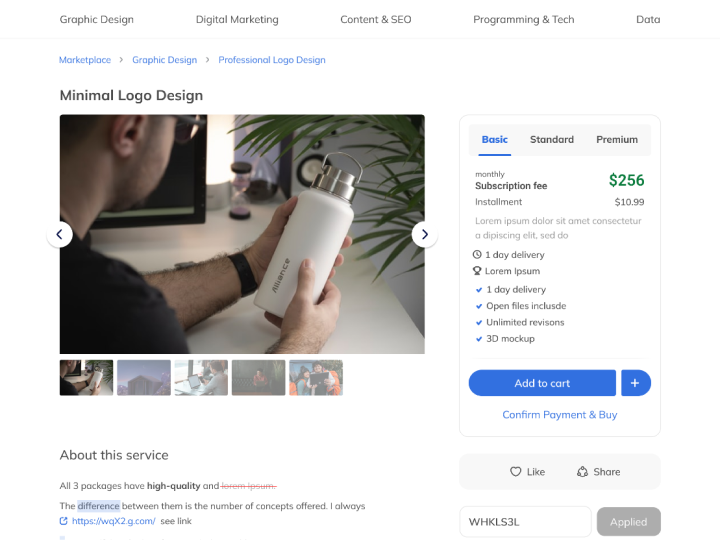Are you familiar with the purpose of a landing page? If not, don’t worry – you’re not alone. Each page should have a specific role when constructing a new website or simply tweaking an existing one. While the About page usually presents ‘who we are” and “what we offer,” Landing pages can do much more! They target a specific audience and provide potential customers/clients with information on how they can get started with all of your services and products!
This blog post will explore why every business should have a landing page and what they bring to the table.
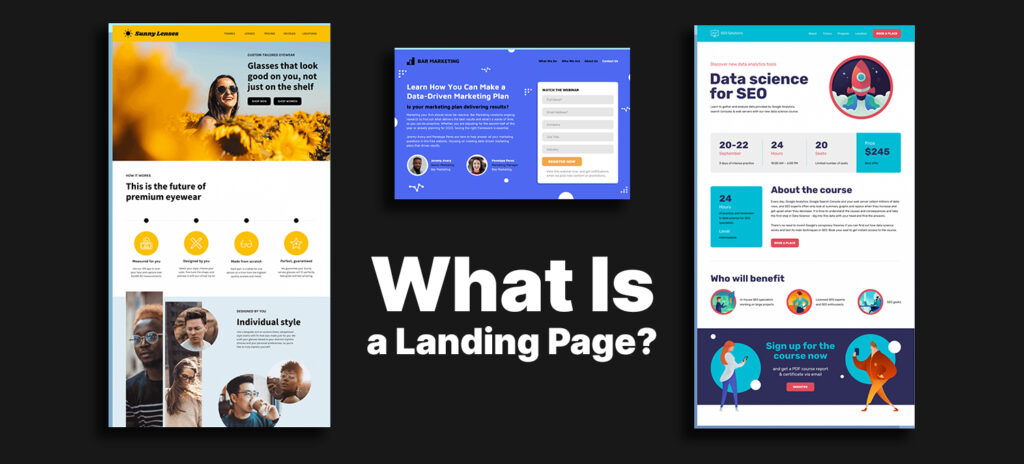
What is a Landing Page?
A website landing page can be considered an online business card, giving visitors a first impression of who you are and what your business offers. It is the initial point of contact for potential customers, giving them an insight into your brand, products, and services. With a 160% higher conversion rate than other signup forms – email vendor selection, your website landing page can drive more leads and potential customers to your business. Optimizing your landing page with compelling visuals and pertinent information can give visitors a positive introduction to your brand. A well-designed landing page should:
1) Provide relevant information quickly
A streamlined, distraction-free landing page can increase your conversion rates by up to 10% – email vendor selection. By minimizing distractions, visitors can quickly and easily learn more about your business, products/services, and mission without sifting through unnecessary content. Include all relevant information, such as contact details, pricing plans, customer testimonials, etc., to ensure visitors can easily find out more about your business. Use visuals and concise text to make the content accessible and engaging. Ensure the page is optimized for desktop and mobile devices to ensure visitors have a seamless experience regardless of device.
2) Guide visitors through the conversion process
The ultimate goal of most landing pages is to generate leads or convert sales. To achieve this, it’s essential to make it as easy as possible for visitors to take action. This means providing clear instructions and avoiding distractions. This can be done by giving a straightforward call-to-action, such as signing up for a newsletter, downloading an eBook, or purchasing a product/service and ensuring the desired action is visible and accessible. Research has shown that personalized CTAs are 202% more effective than generic CTAs – email vendor selection. Customizing your CTA to fit your visitors’ needs will dramatically impact your landing page’s success. Following these simple paths will allow you to maximize the potential of your landing page and increase conversions.
3) Offer personalization options
There are many ways to customize your landing page to appeal to your target audience. Using targeted content, creative visuals, and video backgrounds, you can create an engaging and memorable experience for visitors. This will make them more likely to want to buy what you’re selling and increase their chances of returning in the future. Ensure you use high-quality images, videos, and text that fit your brand’s values and tone of voice. Research shows that adding videos to landing pages increases conversions by a whopping 86% – email vendor selection, making it one of the most effective techniques for boosting sales and increasing customer retention. With the right combination of elements, you can create a captivating landing page that drives conversions and builds long-term customer loyalty.
Are you looking for a way to drive more leads and convert sales for your business? Landing page development is the answer! When done correctly, it can be a potent tool for turning visitors into customers and boosting your bottom line.
Discover how to create an effective landing page to capture users’ attention and increase conversion rates. With the right strategies, you can build a landing page that attracts visitors and helps your business grow.
Start on the path to success today! Learn how to create a landing page that converts and drives profits for your business.
How’s the homepage different from the landing page?
The homepage of a business website serves as the main entry point, providing visitors with an overview of who you are and what your business offers. In comparison, a landing page focuses on a single campaign or offer. Creating multiple landing pages for your business can increase leads by up to a staggering 55% – Hubspot, making it an essential strategy for companies looking to grow their customer base. The landing page encourages conversions, such as signing up for a newsletter or buying a product/service, by introducing users to the core features in just a few seconds. While both pages should have relevant information and visuals, the landing page allows businesses more control over messaging and specific conversion points.
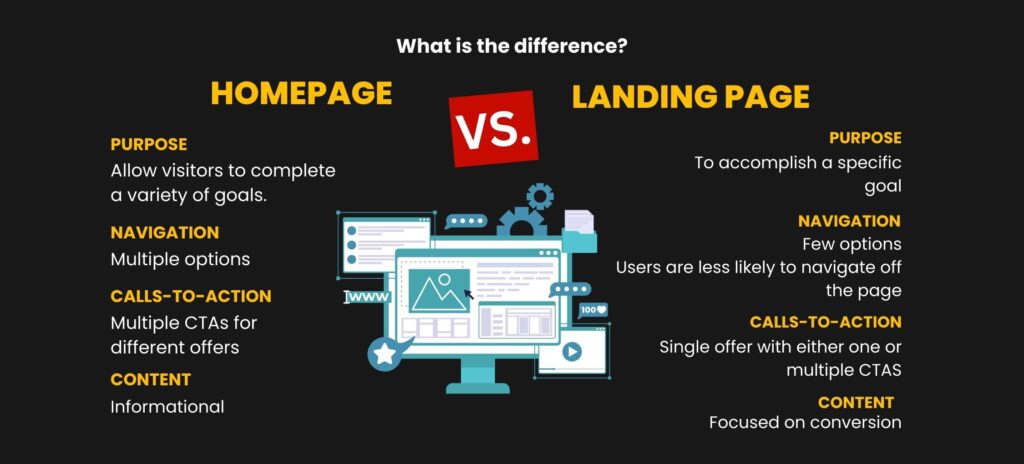
How does a Landing Page work?
A landing page works according to the following steps.
1) Create an Offer
Before designing a landing page, you must first decide on the type of campaign or offer you are running. This could range from product promotions to newsletters and digital downloads. It’s important to remember that including more than one offer on a page can drastically reduce conversion rates by as much as 266% – thrivemyway. It’s best to focus on one offer per page for maximum success. Once you have identified the offer, you can design your landing page for a successful campaign.
2) Develop a Landing Page
Next, you should create a landing page that reflects the offer. Your landing page should clearly explain what users will get when they complete the desired action (e.g., newsletter sign-up), including any bonuses or exclusive discounts. Ensure to include relevant images, videos, and links that provide additional details about the company and its products/services to help visitors make an informed decision. Additionally, include a prominent call-to-action button that is easy to find and click on so users can quickly complete the offer. With only one call-to-action on your landing page, you can achieve up to 1.6% more conversions than if you had two or more – Unbounce. That’s a significant boost in performance, and it’s easy to get when you keep your landing page focused on just one offer.
3) Promote the Landing Page
Once the landing page is complete, you can leverage various marketing channels to drive more qualified leads and reach a larger audience. Strategies such as email campaigns, social media posts, targeted ads, pay-per-click (PPC) ads, content marketing, and search engine optimization (SEO) can help you maximize the visibility and effectiveness of your landing page. 82% of marketers understand the importance of content marketing and are actively using it to reach their goals – Hubspot. This demonstrates how powerful content marketing can be as an effective tool for driving leads and creating conversions. With the right mix of strategies and tactics, you can ensure the right people see your landing page at the right time.
4) Let the Visitors Complete the Action
Visitors can take the desired action quickly and easily by clicking on your compelling Call-to-Actions (CTAs). These CTAs will transfer them directly to your landing page, where they can fill out forms and provide essential information that marketers can use to convert leads into sales. Utilizing the word “submit” as a Call-to-Action (CTA) can decrease conversion rates by as much as 3% – Unbounce. Ensure your CTAs are clear, concise, and eye-catching to maximize conversions!
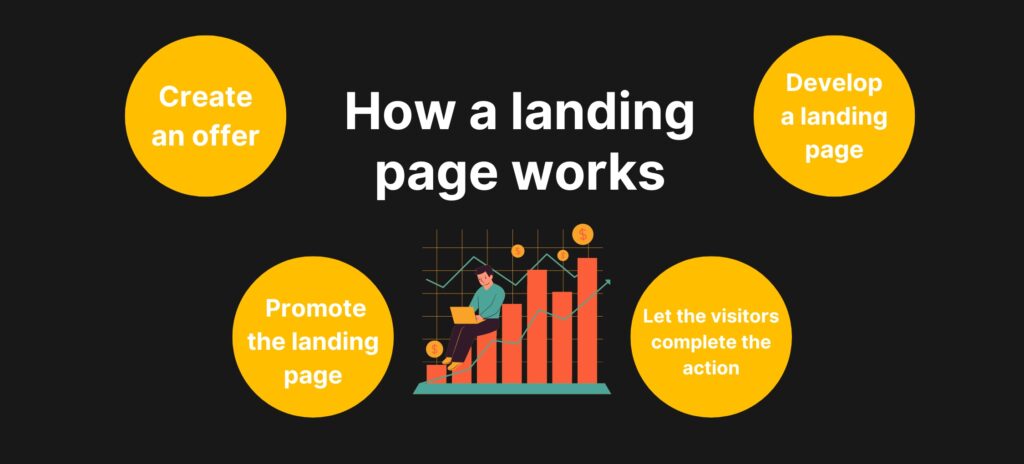
Why does a Business Website need a Landing Page?
Landing pages are critical to achieving success online. By creating a dedicated page for each of your visitors, you can maximize conversions and boost profits. Creating dynamic landing pages can help businesses convert up to 25.2% more mobile users than a standard landing page – Merkle. You can ensure that visitors have easy access to the information they require and that they can take action by optimizing your website. With the right strategies, you can provide your landing pages to work hard to drive more sales and increase profits. Here are some of the advantages of creating landing pages for business websites:
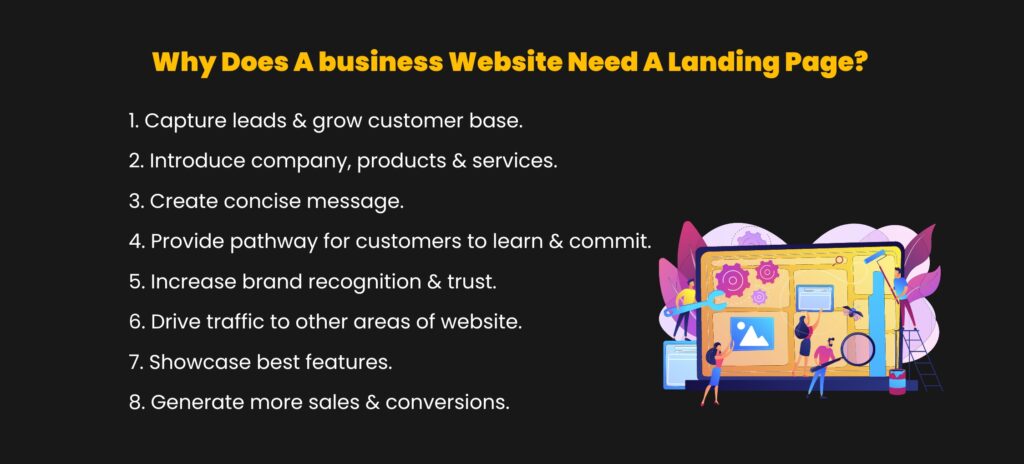
1) Generate Leads
The main goal of business websites is to generate leads and convert sales. By creating a solid landing page, businesses can funnel visitors to specific campaigns and offer to encourage them to take action, such as signing up for newsletters or purchasing products/services. With an effective landing page, businesses can improve conversion rates, helping them achieve their goals faster. By addressing the concerns of potential buyers, companies can increase their conversion rates by as much as 80% – email vendor selection. Creating a powerful landing page and addressing customer concerns can help businesses generate leads and convert customers quickly and efficiently.
2) Build Trust with Potential Customers
The content and visuals on a business’s landing page give potential customers a first impression of what they can expect when engaging with their business. To build trust and encourage customer engagement, clearly communicate your company mission, product offerings, contact details, customer testimonials, and other vital information to help create a positive user experience. According to recent research, an impressive 36% of the top landing pages feature customer testimonials – email vendor selection, so adding this element to your page is worth considering. With this front-and-center information on your landing page, potential customers will likely become loyal.
3) Create Targeted Experiences
A business website’s landing page should be tailored to the current campaign, which can boost conversions by 300% or more – techjury. It should offer visitors a seamless, memorable experience. This means that the content, visuals, and call-to-actions must match what visitors will receive if they take action on the page. Creating an effective landing page in this manner resonates with potential clients and inspires them to transform.
Types of Landing Pages
1) Transactional Landing Pages
These focus on converting visitors into paying customers. They have a form that allows business owners to collect customer data and generate leads or a clear CTA that makes the visitor buy your product or service. To maximize the effectiveness of these pages, it is crucial to design them with simplicity and clarity in mind: use only essential information that provides a complete understanding of the offers or campaigns being promoted. This will help to ensure potential customers are engaged and motivated to take action.
2) Referential Landing Pages
These pages are designed to help business owners get greater visibility and exposure. They give potential customers an overview of the business, its services, and special offers or promotions. Visuals and calls to action can be included to encourage visitors to take further action, such as signing up for a newsletter or exploring other pages on the website. This can help increase sales and generate more leads.
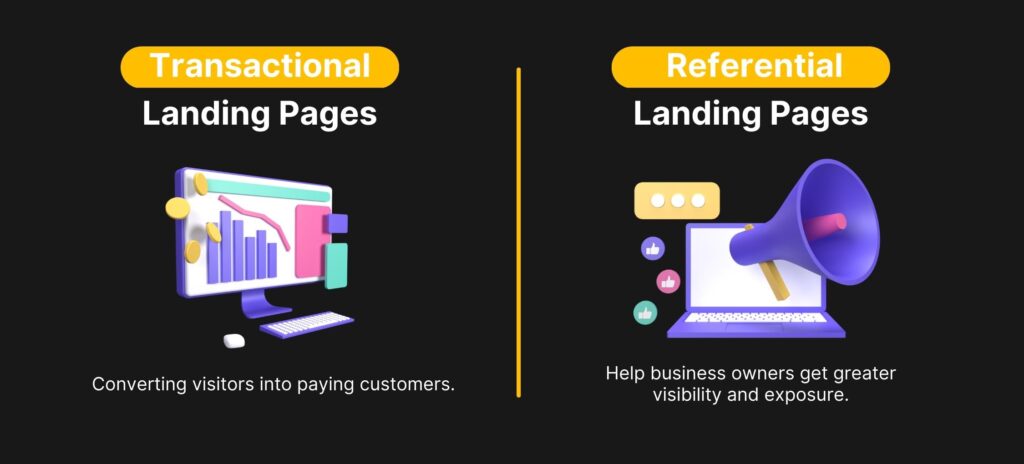
Components of a Landing Page – Things to Add & Not
1) Headline
The headline is the first thing visitors see when they land on your page. 8 out of every 10 people who visit your page will read it, while only 2 out of 10 will read the rest of the content – CopyBlogger. That’s why it’s crucial to get it right. You should ensure it’s clear, concise, and attractive enough to grab attention.
2) Sub-headlines
Include relevant information that supports the headline while explaining more about the business’s offer or campaign.
3) Call to Action (CTA)
CTAs are buttons or links that prompt users to take action, such as subscribing to a newsletter. A clear CTA on a landing page is critical for increasing conversions. Research shows that 51.3% of landing page CTA buttons are green, making it the most popular choice among marketers when looking to drive conversions– Chart Mogul. So if you want to capture more leads, adding a green CTA button to your page could be the way to go.
4) Images/Videos
Choose visuals that reflect the business’s offer and attract the attention of potential customers. Approximately half of online users prefer watching videos about a product/service before buying – Hallam. Ensure adding images and videos relevant to the messages in other page elements.
5) Social Proof
Social evidence convinces customers that they’re making the right decision by signing up for your offer or campaign. For example, add customer reviews, case studies, or related awards/ certifications to increase credibility. Nearly 9 out of 10 consumers trust reviews and customer testimonials when making purchase decisions – Search Engine Land.
6) Consent Box
Consider adding a checkbox to the landing page that visitors must select to proceed further. It’s essential to ensure this box is clear, with information about how the business uses customer data and other necessary details.
7) Remove Site Navigation
Only 16% of landing pages are designed to direct potential customers to take action on the business’s offers without any distractions, allowing them to stay focused on the offer – MarketingExperiments. Additional navigational links can detract the viewers. Therefore, remove all extra navigation from the page immediately!
8) Use bullet points to provide details
Use bullet points to mention the features and benefits of the business’s offers or campaigns. This strategy makes it easier for potential customers to find the information they need quickly, increasing the chances for conversions.
9) Lead Form
A business website must include essential landing page components to capture customer data. Use an online form to collect customers’ names, email addresses, and other relevant information to help you understand your potential customers. Having just 3 form fields can result in a 10% conversion rate – email vendor selection – a 10% chance of turning visitors into customers with just a few clicks! If necessary, include optional fields to gain further insight into their needs and preferences.
10) Convey the value of your offer
Aim to clarify why potential customers should take action on your offers or campaigns. Offer a mix of features and benefits that show potential customers what they can gain from signing up and how the business can help them achieve their goals.
11) Add Social Sharing Icons
If you want more people to know about your business and its offers, put social sharing icons on your landing pages. This technique will let visitors quickly share your business with their friends and family, which will help expose it to more people and increase conversions.
These landing page tips can create compelling pages that maximize conversions and increase sales. Landing pages are essential to any business website, so you should notice them when developing websites for your business.
Ways To Promote A Landing Page
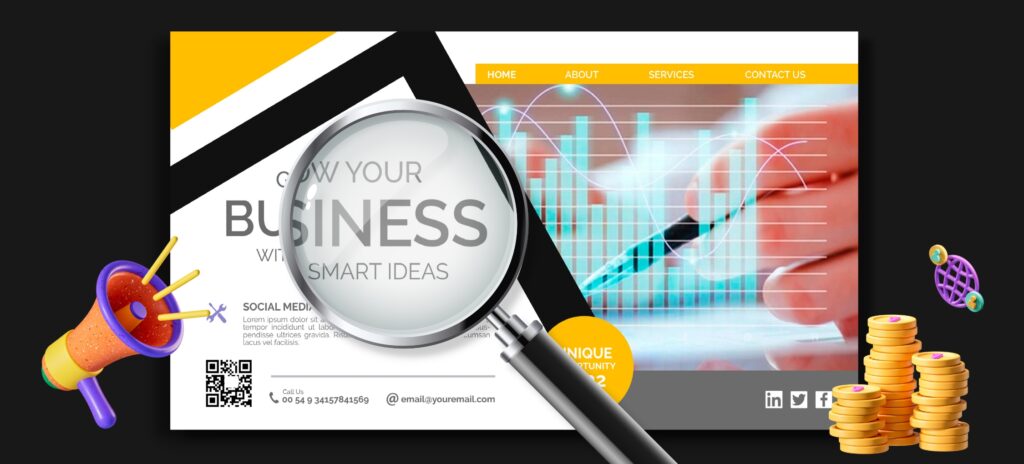
1) Email Marketing
Email campaigns are an effective way to promote your business’s landing page and convert leads into customers. To get started, create a list of prospects and craft personalized emails containing a link to your landing page. Then, send them out to your target audience. Nearly 80% of business leaders agree that when their customers receive a personalized experience, they spend an average of 34 percent more than they otherwise would – the loop marketing. Using email campaigns, you can build relationships with prospects and turn them into paying customers!
2) Paid Marketing
Paid ads are another great way to get the word out about your business offers or campaigns. With carefully targeted campaigns on platforms like Google Adwords,, Facebook, Instagram, and Twitter, you can maximize your advertising budget and reach your desired results.
3) Social Media Marketing
Use social media to promote your business landing pages and gain more exposure. Recent studies have found that businesses are increasingly investing in social media, with the average company dedicating an impressive 14.9% of its marketing budget to this powerful platform – wordstream. Take advantage of tools such as Twitter Cards and Facebook Instant Articles to increase click-throughs on your business landing page links. This will increase traffic to your website’s landing pages, resulting in more conversions.
4) Optimize Content For SEO
According to 49% of businesses, organic search is one of the best marketing strategies to create a great return on investment (ROI) – wordstream. This makes optimizing your website content for search engine optimization (SEO) even more critical. Proper SEO strategies can help you rank higher in search results and give you more visibility in front of potential customers.
With these strategies, you can ensure that your business reaches its maximum potential.
WRAP UP
Landing pages are essential for any business that wants to succeed online. They provide a single point of contact for customers and offer them an easy way to learn more about your product or service. If you still need a landing page, now is the time to create one. And if you already have one, take some time to review it and see if there’s anything you can do to make it more effective.
Are you looking to create or optimize a landing page that converts? Let our team of experts help you out! We specialize in crafting customized landing pages that are designed to turn leads into customers. Our landing pages are the perfect way to increase your conversions with visually appealing visuals, persuasive copy, easy-to-fill forms, and clear call-to-action. Don’t wait any longer.
Head to our Contact Us page now, and let us show you what we can do for you. We look forward to hearing from you!





 Unlock the Limitless Possibilities of Chat GPT: ..
Unlock the Limitless Possibilities of Chat GPT: .. Unlock the Magic of Artificial Intelligence Stor..
Unlock the Magic of Artificial Intelligence Stor.. Chatbot Marketing: Ignite Your Digital Marketing..
Chatbot Marketing: Ignite Your Digital Marketing..

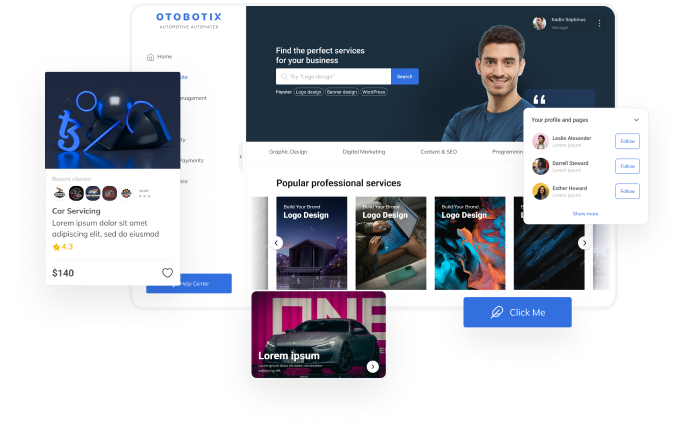






.png)
